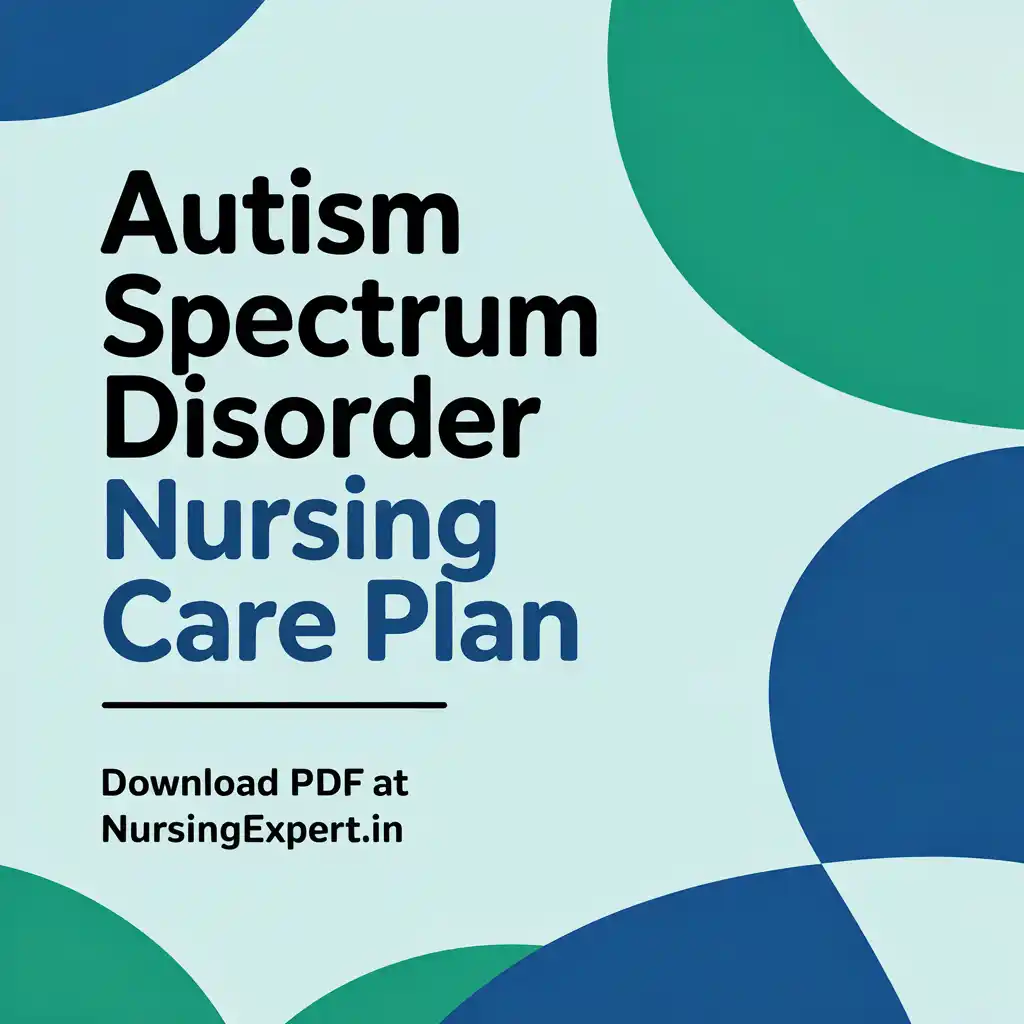Nursing Care Plan for Autism Spectrum Disorder: Autism Spectrum Disorder (ASD) is a neurodevelopmental condition characterized by challenges in social communication and repetitive, restrictive behaviors. It affects individuals differently, and early intervention can make a significant impact on overall development and quality of life. For nursing students and professionals, a clear and evidence-based care plan is crucial to support children and adults with ASD. This guide presents 5 nursing care plans for managing ASD, covering thorough assessments, tailored interventions, patient and family education, and emotional support. A sample 7-column nursing care plan template is provided below, along with frequently asked questions (FAQs) and a downloadable PDF resource available at NursingExpert.in.
Thank you for reading this post, don't forget to subscribe!
What is Autism Spectrum Disorder (ASD)?
Autism Spectrum Disorder is a developmental condition that affects communication, behavior, and social interaction. Individuals with ASD may have difficulties in social reciprocity, exhibit repetitive behaviors, and may be sensitive to sensory stimuli. The condition varies in severity and can be managed effectively with early diagnosis, appropriate interventions, and ongoing support.


Causes and Triggers
The exact cause of ASD is not fully understood, but several factors are believed to contribute:
- Genetic Predisposition: Family history can increase the likelihood of developing ASD.
- Environmental Factors: Prenatal exposure to toxins or infections may play a role.
- Neurological Differences: Variations in brain structure and function.
- Early Developmental Factors: Complications during pregnancy or birth may also contribute.
Symptoms of ASD
Common signs and symptoms include:
- Difficulty in social interaction and communication
- Repetitive behaviors or rigid routines
- Sensory sensitivities (e.g., to light, sound, textures)
- Challenges in understanding social cues and empathy
- Preference for solitude and restricted interests
- Delayed language or unusual language patterns
Nursing Care Plans & Management for ASD
A structured nursing care plan for Autism Spectrum Disorder focuses on:
- Improving Communication Skills: Enhancing verbal and non-verbal communication.
- Managing Behavioral Challenges: Addressing repetitive or disruptive behaviors.
- Supporting Sensory Integration: Helping patients manage sensory sensitivities.
- Promoting Social Interaction: Facilitating positive social engagements.
- Educating Families: Empowering families with knowledge and strategies for home care.
Nursing Problem Priorities
- Impaired Social Interaction and Communication
- Risk for Self-Injurious Behavior
- Ineffective Coping Mechanisms
- Sensory Processing Issues
- Knowledge Deficit Regarding ASD Management
Nursing Assessment and Diagnostic Findings
- Communication Evaluation: Assess verbal and non-verbal skills.
- Behavioral Assessment: Identify repetitive behaviors and triggers.
- Sensory Evaluation: Document sensory sensitivities and responses.
- Functional Assessment: Evaluate the ability to perform daily activities.
- Patient and Family History: Gather information on developmental milestones and previous interventions.
- Physical Examination: Check for any co-existing medical issues.
Nursing Goals
Short-Term Goals
- Enhance Communication: Improve the patient’s ability to express needs using alternative communication methods within 24 hours.
- Reduce Behavioral Outbursts: Lower the frequency and intensity of disruptive behaviors within 24–48 hours.
- Improve Sensory Integration: Help the patient manage sensory sensitivities effectively within 24 hours.
- Provide Emotional Support: Reduce anxiety and improve coping strategies within 24 hours.
- Educate Family: Ensure that family members understand the care plan and supportive strategies within 24 hours.
Long-Term Goals
- Promote Social Skills: Enhance social interaction and communication over the next several weeks.
- Improve Daily Functioning: Enable the patient to participate more independently in daily activities.
- Maintain Behavioral Stability: Sustain reduced behavioral outbursts and improved coping mechanisms.
- Enhance Quality of Life: Improve overall emotional and physical well-being through continuous support and follow-up.
- Ensure Long-Term Education: Empower the patient and family with ongoing knowledge for effective management of ASD.
Nursing Interventions and Actions
- Enhancing Communication Skills
- Interventions:
- Introduce communication aids such as picture boards or apps.
- Encourage the use of simple, clear language during interactions.
- Collaborate with speech therapists for specialized support.
- Rationale: Enhancing communication reduces frustration and improves social interactions.
- Interventions:
- Managing Behavioral Challenges
- Interventions:
- Identify triggers and document behavior patterns.
- Implement behavior modification techniques and positive reinforcement.
- Use structured routines to provide a predictable environment.
- Rationale: Consistent behavior management reduces the frequency of outbursts.
- Interventions:
- Supporting Sensory Integration
- Interventions:
- Assess sensory sensitivities and tailor the environment to reduce overwhelming stimuli.
- Provide sensory integration therapy or activities.
- Use calming techniques like soft music or weighted blankets if appropriate.
- Rationale: Reducing sensory overload can improve focus and decrease anxiety.
- Interventions:
- Promoting Social Interaction and Independence
- Interventions:
- Encourage participation in group activities and social skills training.
- Support the patient in practicing self-care activities under supervision.
- Collaborate with occupational therapists to develop daily living skills.
- Rationale: Enhancing social and self-care skills improves overall independence.
- Interventions:
- Patient and Family Education
- Interventions:
- Provide clear, concise written and verbal information about ASD.
- Use the teach-back method to confirm understanding.
- Offer resources for support groups and counseling.
- Rationale: Informed families are better able to support the patient and maintain adherence to care plans.
- Interventions:
Sample Nursing Care Plan for Autism Spectrum Disorder
| Nursing Diagnosis | Patient Goals/Expected Outcomes | Assessment Data | Nursing Interventions | Rationale | Evaluation | Documentation/Follow-Up |
|---|---|---|---|---|---|---|
| Impaired Social Interaction | Improve non-verbal and verbal communication within 24 hours | Patient shows limited eye contact and minimal verbal response | Introduce communication aids; use simple language; collaborate with a speech therapist | Enhances communication and reduces frustration | Patient uses communication aids effectively | Record communication progress and therapy sessions |
| Risk for Self-Injurious Behavior | Reduce instances of self-harm within 48 hours | Patient exhibits repetitive self-injurious behavior | Implement behavior modification techniques; use positive reinforcement; provide a structured routine | Reduces risk of injury and promotes safer behavior | Self-harm episodes decrease; behavior improves | Document behavior patterns and intervention outcomes |
| Sensory Processing Deficit | Improve sensory tolerance and reduce overstimulation within 24 hours | Patient is sensitive to loud noises and bright lights | Modify the environment to reduce sensory overload; use calming activities; collaborate with an OT | Reduces sensory triggers and improves comfort | Patient shows less sensitivity; reports increased comfort | Document environmental modifications and patient feedback |
| Impaired Physical Function | Enhance ability to perform daily activities with minimal assistance within 48 hours | Difficulty performing ADLs; reduced fine motor skills observed | Encourage participation in self-care activities; provide assistance and adaptive devices | Promotes independence and improves quality of life | Increased participation in ADLs; improved motor skills | Record functional assessments and ADL progress |
| Knowledge Deficit | Patient and family will accurately describe the care plan and management strategies within 24 hours | Family expresses uncertainty about ASD management | Provide clear, written instructions; use teach-back method; offer counseling and support group information | Empowers families to support the patient effectively | Family demonstrates understanding and adherence | Document educational sessions and verify comprehension |
Downloadable PDF Resource
For your convenience, a detailed Nursing Care Plan for Autism Spectrum Disorder is available as a downloadable PDF.
Download the Nursing Care Plan for Autism Spectrum Disorder PDF Here at NursingExpert.in
Frequently Asked Questions (FAQs)
- What is Autism Spectrum Disorder (ASD)?
ASD is a neurodevelopmental disorder that affects communication, behavior, and social interaction. - What are common symptoms of ASD?
Symptoms include difficulties in social communication, repetitive behaviors, and sensory sensitivities. - How is ASD diagnosed?
Diagnosis is based on developmental history, clinical evaluation, and standardized assessments by specialists. - What are the key nursing interventions for ASD?
Interventions include enhancing communication, managing behavior, supporting sensory integration, and providing patient education. - Where can I download the PDF for this care plan?
You can download the free PDF resource from NursingExpert.in.
Conclusion
Autism Spectrum Disorder poses unique challenges that require a compassionate and structured approach. By following these 5 nursing care plans, Indian nursing students and professionals can effectively support the communication, behavioral, and sensory needs of patients with ASD. Use this guide and the downloadable PDF from NursingExpert.in to enhance your clinical practice and provide high-quality, patient-centered care.
References and Sources
- National Institutes of Health (NIH). (2023). Autism Spectrum Disorder: Overview and Management. Retrieved from https://www.nih.gov
- Centers for Disease Control and Prevention (CDC). (2023). Autism Spectrum Disorder Information. Retrieved from https://www.cdc.gov
- American Nurses Association (ANA). (2022). Standards for Nursing Practice. Retrieved from https://www.nursingworld.org
- MedlinePlus. (2023). Autism Spectrum Disorder. Retrieved from https://medlineplus.gov
- World Health Organization (WHO). (2023). Guidelines on Neurodevelopmental Disorders. Retrieved from https://www.who.int


